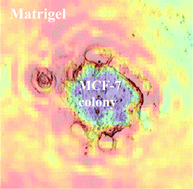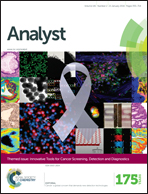FTIR imaging of the 3D extracellular matrix used to grow colonies of breast cancer cell lines†
Abstract
Infrared imaging was applied to investigate a reconstituted basement membrane, known as Matrigel, in three-dimensional cell cultures. Matrigel, in the vicinity of the colonies, was examined for four breast cancer cell lines presenting different 3D colony morphologies. MCF-7 and T-47D present mass colonies, SKBR-3 grape-like colonies and MDA-MB-231 stellate colonies associated with a more invasive phenotype. The edge of the cell colonies was found to be significantly depleted in Matrigel. Except in a limited number of cases, Matrigel appeared to be thinner at the edges of the colonies but not completely destroyed or torn off as it would be for a purely mechanical effect. When a PCA was run on the spectra of one or several colonies, the score images on PC#3 and PC#4 presented structures in the Matrigel areas which appeared as fringes, lines, dots or regular patterns. This effect represents a very small fraction of the total variance but is reproducible for all the 4 cell lines. PC#4 presents systematically a maximum near 1624 cm−1 and a minimum around 1700 cm−1. When spectra are normalized, the effect is less marked but does not disappear. The nature of the variations that exist in the Matrigel layer is therefore not solely related to thickness but also to the chemical composition. At this stage, the weakness of the effect prevents a thorough investigation.

- This article is part of the themed collection: Innovative Tools for Cancer Screening, Detection and Diagnostics

 Please wait while we load your content...
Please wait while we load your content...